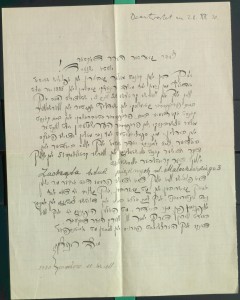During my visit at the University of Toronto’s Thomas Fisher Rare Book Library, I “found” in the Otto Schneid archives a handwritten Yiddish letter that Moshe Rynecki wrote to Otto Schneid. While the mystery of WHAT the letter says has been solved, there are now new mysteries about the contents of the letter. I’m working on that, but welcome any assistance you may be able to offer. Here is the original letter and the translation:
Otto Shneyd!
I am an artist, a painter, born in the year 1885 in the small Polish town of Shedlits. My name is Moyshe Rinetsky [Rynecki]. I now live in Warsaw at 24 Kradzhe [Krucza] St. Apt. [?] 9. I studied [first] with Professor Gievski in Shedlits, and later at the Warsaw Art Academy with Professor Stabrovski and with the painter, Tshebinski, and Professor Hershtayn. He now lives in Berlin. My specialty is only painting Jewish folk scenes. I have been exhibiting paintings the last few years at the Jewish Art Exhibition in Warsaw at 51 Kralevske [St.] and at the Christian exhibition as well.
Zachęta Sztuk Pięknych, ul. Machałowskiego 3 [Society of Encouragement of Friends of Fine Arts in Warsaw]
The Polish press, as well as the Jewish [This could also be the “Yiddish” press. In Yiddish, both words are the same] Press, have written a lot about me already. And [what they wrote was] favorable. I do not think that this is interesting, so I am enclosing a German newspaper and several reviews of my paintings. With much hope that I will be honored by your response [?], Sir Doctor [herr doktor],·· I thank you, in advance, most sincerely and sign most respectfully,
Moyshe Rinetsky
Warsaw, December 11, 1930
Yiddish is written using the Hebrew alphabet. As I understand it, the words are sounded out to create as close an approximation to the original sound as possible. So, for example, when written in Yiddish, RYNECKI ends up being written as RINETSKY (the Polish pronunciation), SCHNEID becomes SHNEYD, and the town SIEDLCE becomes SHEDLITS. This is fine because I know and recognize these names, but this becomes a problem for me in this letter because of the mention of several names I don’t know and am now eager to research.
In the letter my great-grandfather says that he worked with a variety of professors and artist mentors. I recognize two of the four names:
Tshebinski I know of as Trzebinski, who wrote about my great-grandfather in his own memoir.
I had not heard the name Stabrovski before, but I see an entry about him on Wikipedia.
I cannot find anything about Gievski or Hershtayn. I have tried the alternate spellings of: GIEWSKI and HERSZTAJN. Still, nothing. [12/12/13 9:15 am update. A twitter follower has suggested that perhaps the name Hershtayn is that of Adolf Eduard Herstein. It looks like it really could be him!]
[12/13/2013 update: I have received some more assistance – this time from Poland. As for Gievski, it looks like this is Ignacy Gajewski who is, apparently, mentioned in a book by Jerzy Malinowski as Jewish artists in Poland in 19th and 20th Century.]
Are you an art historian specializing in Polish-Jewish artists of the interwar years? Do you read Yiddish? If so, please do take a look and let me know what you think!
There are, of course, many other very interesting things in this letter and I am thrilled at the opportunity to analyze it in great detail! I am learning so much, and there are only a few lines of text. Imagine if I had more letters….
The thing I love about this letter is that it is handwritten and that it is about Moshe’s own life as an artist. It offers a window into a man who I have come to know through the extension of his paintbrush. That he starts by describing himself as an artist, a painter somehow, at least for me, seems powerful, important. He thought of himself first and foremost as an artist. Painting was what most inspired him in life.
The thing I find interesting and incredibly surprising is that he says he was born in 1885. His son, my grandfather, George, always said his father was born in 1881. This four year difference hardly matters today, but I am intrigued by why my grandpa George either remembered it incorrectly or purposefully changed it. OR is this perhaps a problem of a calendar change with the Russian calendar system? It is a curious mystery to me.
What’s the saying?…For every question that gets answered, there are four more that arise in its place?
I continue to be astounded and rewarded in immeasurable ways along this most amazing journey.
